-
Welcome back Guest! Did you know you can mentor other members here at H-M? If not, please check out our Relaunch of Hobby Machinist Mentoring Program!
You are using an out of date browser. It may not display this or other websites correctly.
You should upgrade or use an alternative browser.
You should upgrade or use an alternative browser.
Hf 7x10 Spindle, Bearing, & Transmission Gear Replacement
- Thread starter Cavediver
- Start date
- Joined
- Jan 9, 2016
- Messages
- 120
Everything is back together, but it looks like I am going to have to take it all apart again; something is causing vibration. I believe it's one of the new metal gears, however I won't know for sure until I take things apart and sub-out the original plastic gears one at a time. It's a rhythmic vibration (harmonic?), and it happens without the chuck, but only seems to be present in the high-gear range.
Things seem to be pretty concentric with minimal runout according to my cheap dial indicator. I've purchased a test indicator (an older, used Federal) with finer resolution just to make sure
End to end play was also eliminated (agan, according to the cheap dial indicator...). Very little heat was generated during the 30 minute run; just enough to feel by hand in my very, very cold basement shop this weekend. I'm taking home an infra-red thermometer tonight to double check that as well.
So close, yet so far away....
ETA: As part of the testing for the location of the vibration, is there any reason I should not run the lathe in "neutral" (selector held in between the high and low settings, not engaging either gear)? I know I need to be careful doing this, and don't plan on leaving it unattended or running any longer than necessary.
Things seem to be pretty concentric with minimal runout according to my cheap dial indicator. I've purchased a test indicator (an older, used Federal) with finer resolution just to make sure
End to end play was also eliminated (agan, according to the cheap dial indicator...). Very little heat was generated during the 30 minute run; just enough to feel by hand in my very, very cold basement shop this weekend. I'm taking home an infra-red thermometer tonight to double check that as well.
So close, yet so far away....
ETA: As part of the testing for the location of the vibration, is there any reason I should not run the lathe in "neutral" (selector held in between the high and low settings, not engaging either gear)? I know I need to be careful doing this, and don't plan on leaving it unattended or running any longer than necessary.
Last edited:
- Joined
- Jan 26, 2015
- Messages
- 1,939
If you want a retaining adhesive that would work real well try and takes up gaps.
Loctite ® 609™ Retaining Compound, Cylindrical bonding
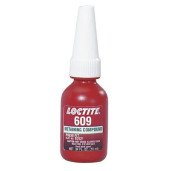
Loctite ® 609™ is a low viscosity, rapid-curing anaerobic adhesive that augments the strength of press fit assemblies or slip fit assemblies up to 0.005"in diameter. Adds up to 3,000 psi holding power. Recommended for parts that will need subsequent dismantling, i.e., retention of bearings onto shafts and into housings.
Technical Data:
Typical applications: Augment press fits
Viscosity: 125cP
Cure Time: Fixture - 10 minutes Full - 24 hours
Max gap fill: 0.12mm
Temperature resistance: 150°C
Shear strength: 15.8 /mm2
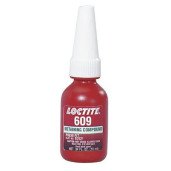
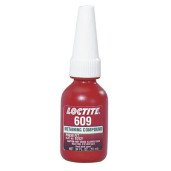
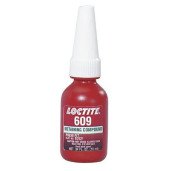
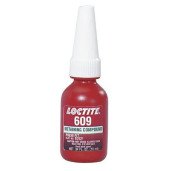
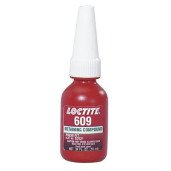
Loctite ® 609™ Retaining Compound, Cylindrical bonding

Loctite ® 609™ is a low viscosity, rapid-curing anaerobic adhesive that augments the strength of press fit assemblies or slip fit assemblies up to 0.005"in diameter. Adds up to 3,000 psi holding power. Recommended for parts that will need subsequent dismantling, i.e., retention of bearings onto shafts and into housings.
Technical Data:
Typical applications: Augment press fits
Viscosity: 125cP
Cure Time: Fixture - 10 minutes Full - 24 hours
Max gap fill: 0.12mm
Temperature resistance: 150°C
Shear strength: 15.8 /mm2





- Joined
- Jan 9, 2016
- Messages
- 120
You could try some Loc-tite 680 to improve that bearing fit.
If you want a retaining adhesive that would work real well try and takes up gaps.
I'm piggy-backing some stuff on a McMaster Carr order at my office in the next day or two (I pay for my goods but get to dodge the shipping charges). One or both of these is going on my list
- Joined
- Jan 8, 2016
- Messages
- 171
Be aware that Loctite 609 is pretty tough stuff once hardened, not easy to remove the part if you need to. "Adds up to 3,000 psi holding power". You won't be able to pry the bearing out with a screwdriver, etc. You need to heat to more than 300F degrees to defeat the stuff. "Temperature resistance: 150°C". So, get it right the first time. 
I've used it to hold motor gears on round motor shafts for model helicopters.
I've used it to hold motor gears on round motor shafts for model helicopters.
- Joined
- Aug 23, 2014
- Messages
- 932
Have you tried it with the chuck installed? If you look at the spindle the bolt pattern is not symmetrical, and this could cause some high speed vibration. If you have no runout radially then there should be no issue with the bearings. I have a 4" chuck on mine with an adapter. I had to drill and counterbore some holes in the adapter and align it so the heavy side was bolted to the light side of the spindle to get rid of an out of balance condition. You could hold the transmission gear handle in neutral if you are very careful and do not let the gears engage until the spindle stops. My lathe is not bolted down to the bench and the out of balance I had made the lathe rock towards and away from me about a quarter of an inch. After drilling and counterboring the adapter and getting the adapter and spindle in the best orientation I had no vibration at all. The metal gears are noisy but have not made any vibration or out of balance on mine. Maybe you got a defective set. Replacing one at a time as you said should help find the culprit.
- Joined
- Jan 9, 2016
- Messages
- 120
I've run it both with and without the chuck. The vibration is there without the chuck mounted, and it gets worse once it's installed.
I am going to have to think this through before starting on anything. There's nothing worse than random attack problem solving Once I think of everything I can check or test for I will begin, likely this weekend. I've got a pretty good list going and a good idea on how I'm going to get through it.
Once I think of everything I can check or test for I will begin, likely this weekend. I've got a pretty good list going and a good idea on how I'm going to get through it.
To help resolve my issues I bought a test indicator on Ebay. It arrived today, and only then did I realize I don't have anything that'll clamp on the dovetail. (Facepalm). I'm going to look around on Amazon for a decent mag base and holder set. The Noga looks really, really nice... Hopefully I will have one in hand by this weekend.
I am going to have to think this through before starting on anything. There's nothing worse than random attack problem solving
To help resolve my issues I bought a test indicator on Ebay. It arrived today, and only then did I realize I don't have anything that'll clamp on the dovetail. (Facepalm). I'm going to look around on Amazon for a decent mag base and holder set. The Noga looks really, really nice... Hopefully I will have one in hand by this weekend.
- Joined
- Jan 9, 2016
- Messages
- 120
I took a better look at things last night, and I ran the lathe win Neutral, low, and high speed ranges, spindle only, no chuck.
There is a tiny bit of vibration in neutral throughout the full range of motor speeds.
There is a little more vibration in low gear, also fairly consistent throughout the full range. Not great, but I think it's acceptable given the inexpensive motor, the motor mounting method, etc. Even at max speed (low gear) the vibrations are not too bad.
High gear is where the problem lies. In high gear at low speed there is more vibration. At the middle of the range (assuming that's around the same as low gear / max speed?) it gets bad. When I push it to max speed it's absolutely unusable.
I'm hoping (and I think I am correct) this means I am right about one or both of the metal gears causing the issue. I am going to rig a holder for my DTI this evening just to make sure everything is in line with minimal runout. Once that is done I'll be tearing it down again.
Good times!
There is a tiny bit of vibration in neutral throughout the full range of motor speeds.
There is a little more vibration in low gear, also fairly consistent throughout the full range. Not great, but I think it's acceptable given the inexpensive motor, the motor mounting method, etc. Even at max speed (low gear) the vibrations are not too bad.
High gear is where the problem lies. In high gear at low speed there is more vibration. At the middle of the range (assuming that's around the same as low gear / max speed?) it gets bad. When I push it to max speed it's absolutely unusable.
I'm hoping (and I think I am correct) this means I am right about one or both of the metal gears causing the issue. I am going to rig a holder for my DTI this evening just to make sure everything is in line with minimal runout. Once that is done I'll be tearing it down again.
Good times!
- Joined
- Jan 9, 2016
- Messages
- 120
I think I have tracked down the problem. The drive shaft gear has a slightly smaller space between the rings of teeth, and this is binding on the fork in some positions. I have reinstalled the original plastic gear, and it appears room be much smoother, at least when turned by hand.
Now that I have a decent measuring setup, I can see how little it takes to go from "not tight enough" to "too tight". I need a better second wrench and a way to lock the spindle in place, and then (maybe) I can get this part of the project wrapped up.
For the record, I made marks on both the spindle and the drive shaft with a sharpie when I felt drag. After a few rotations, it became obvious that the problem was on the drive shaft. Once I knew where to look, I found I could see the fork shifting here and there. Manipulating it by hand while rotating the shaft made things a bit smoother. Rather than trying to grind and fix, and maybe ruining one or both parts, I decided to go back to the plastic gear and save the repairs until I gain a bit of experience (or wreck the plastic gear and amore forced to make the swap...).
Now that I have a decent measuring setup, I can see how little it takes to go from "not tight enough" to "too tight". I need a better second wrench and a way to lock the spindle in place, and then (maybe) I can get this part of the project wrapped up.
For the record, I made marks on both the spindle and the drive shaft with a sharpie when I felt drag. After a few rotations, it became obvious that the problem was on the drive shaft. Once I knew where to look, I found I could see the fork shifting here and there. Manipulating it by hand while rotating the shaft made things a bit smoother. Rather than trying to grind and fix, and maybe ruining one or both parts, I decided to go back to the plastic gear and save the repairs until I gain a bit of experience (or wreck the plastic gear and amore forced to make the swap...).

